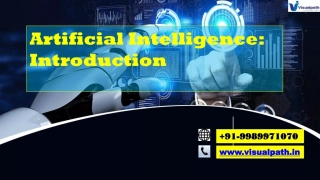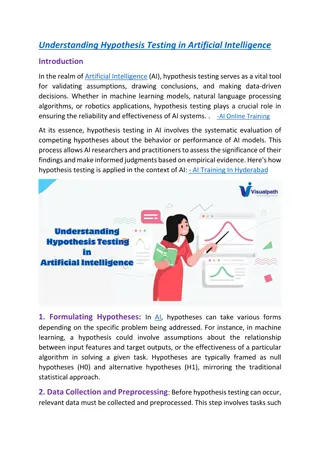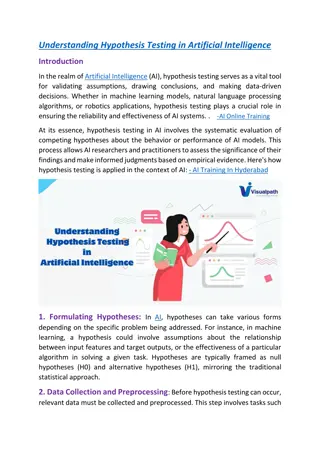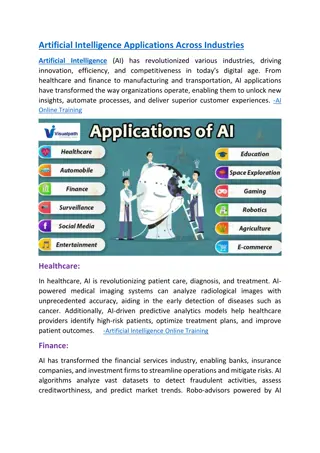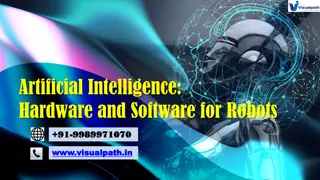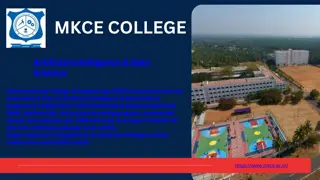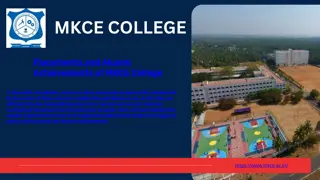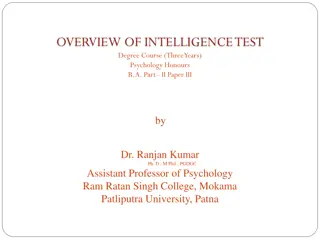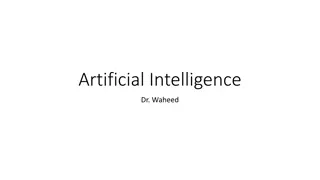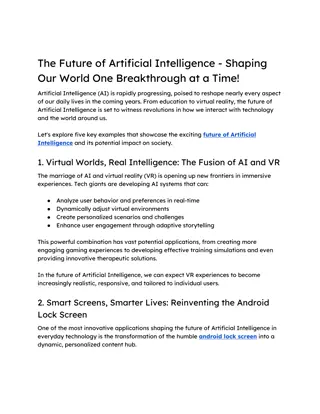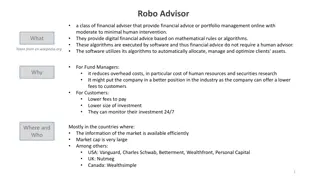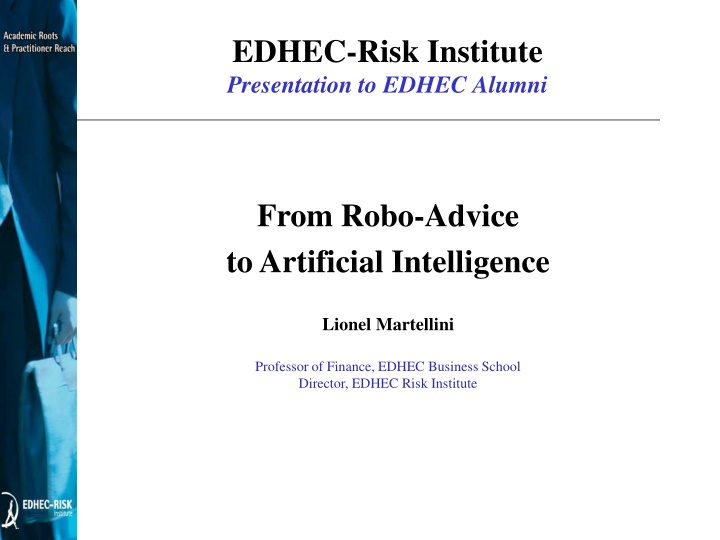
Robo-Advisors and the Future of Investment Management
Explore the impact of robo-advisors in the digital industrial revolution on investment management, focusing on cost efficiency, smart factor index building blocks, and goal-based dialogues. Discover how robo-advisors bridge the gap between traditional wealth management and online brokerage, paving the way for a new paradigm in financial advice.
Download Presentation

Please find below an Image/Link to download the presentation.
The content on the website is provided AS IS for your information and personal use only. It may not be sold, licensed, or shared on other websites without obtaining consent from the author. If you encounter any issues during the download, it is possible that the publisher has removed the file from their server.
You are allowed to download the files provided on this website for personal or commercial use, subject to the condition that they are used lawfully. All files are the property of their respective owners.
The content on the website is provided AS IS for your information and personal use only. It may not be sold, licensed, or shared on other websites without obtaining consent from the author.
E N D
Presentation Transcript
EDHEC-Risk Institute Presentation to EDHEC Alumni From Robo-Advice to Artificial Intelligence Lionel Martellini Professor of Finance, EDHEC Business School Director, EDHEC Risk Institute
Are Robo-Advisors Useful? We expect that the digital industrial revolution will dramatically impact our lives, but what exactly shall we expect when it comes to investment management? What exact benefits are we going to get: lower cost or better service or both? Cost side: Strong improvement compared to traditional wealth management, not compared to online brokerage. Service side: When facing physical health problems, we know that we need both medicine and also advice from a medical doctor. For our financial health problems, we already have online pharmacies (online brokers), so the question is: do we get online meaningful advice by robo-advisors? 2
Robo-Advisors and the Industrial Revolution Broadly speaking, investors need (i) a cost efficient access to (ii) a mass-customised solution based on (iii) smart factor index building blocks and (iv) a goal-based dialogue. Robo-advisors have allowed a massive step forward on (i) and (iv), but dimension (ii) and (iii) are still missing On the other hand, there is little, if any, connection between the dialogue interface, which is investor-centric, and the advice process, which is somewhat unrelated to the specific nature of the goals at hand. You can t bring the new industrial revolution with a paradigm (modern portfolio theory) dating from 70 years ago! 3
Robots: How Meaningful Are They? Building Blocks Strategy name Asset Allocation Strategy Notes Retirement Planner AUM MPT & Full Scale Optimization to create building blocks, Risk allocation to allocate between the building blocks 6 Building blocks: core equity, non-traditional equity, US inv grade, non traditional bonds, commodities, cash) Schwab Intelligent Portfolios Risk Budgeting (for asset class), ETF cost reducing MPT $8,000,000,000 low cost index funds (stock and bond ETFs), Tax loss Harvesting, different goals (Retirement, Safety Net, Major Purchase..) 2 Asset class (stock or bond) with 12 Building blocs (6 stocks, 6 bonds) Deterministic target date fund: Stock/Bond ratio as function of time (glide path) Betterment "Goal-Based" Investing $5,101,000,000 Solving the efficient frontier Wealthfront 11 Building blocks MPT ETF cost reducing, tax efficient $4,020,000,000 6 Building blocks (US stocks, international stocs, US bonds, international bonds, alternatives, cash) Building blocks construct with equal sector and style weighting (avoid cap-weighted index), tax loss harvesting Nobel Prize investing strategy MPT on the building blocks (based on historical returns) Personal Capital $3,100,000,000 4
Robots: How Meaningful Are They? Cont Building Blocks Strategy name Asset Allocation Strategy Notes Retirement Planner AUM Deterministic Target Date Fund (glide path adjusted yearly) Tax saving , low-fee index funds, presence of factor tilted building blocks 2 Asset class (stock or bond) with 13 Building blocks Future Advisor Dynamic Fund selection $808,000,000 5 Building blocks (US stocks, bonds, real estate, foreign equities, and emerging market stocks) MPT, rebalancing based on risk aversion and retirement timeframe ETF cost reducing (cap- weighted) Rebalance IRA MPT $225,000,000 3 Asset class (stock, real estate, fixed income) with 9 Building blocks Nobel-prize winning portfolio research SigFig MPT, Fix Mix ETF cost reducing, tax efficient $60,000,000 ETF cost reducing, stress test on building block WiseBanyan Asset class allocation MPT MPT $13,000,000 5
Robo-Advisors and Artificial Intelligence In many fields, digital disruption goes hand-to-hand with the development of artificial intelligence. In investment management, machine learning techniques start to prove extremely useful at: Providing new perspectives on existing data sets; Allowing us to analyze alternative, big, data sets. It is unclear, however, how much of this technology, if any, can/should be put at use in robo-advice. Key challenge for robo-advisors is not properly use information about investors goals. 6
Is the Glass Half Empty or Half Full? We are about halfway towards the emergence of truly meaningful cost-efficient mass-customised forms of investment solutions for individuals. Robo-advisors already allow for enhanced cost efficiency and a more meaningful goal-base dialogue, which are important steps forward. A couple of big steps are still needed, however, before we can claim that the industrial revolution in wealth management has finally arrived. We should remain confident that this will eventually happen since all of the required ingredients are now readily available. The wait has already been so long, and the millennials are coming along. 7

